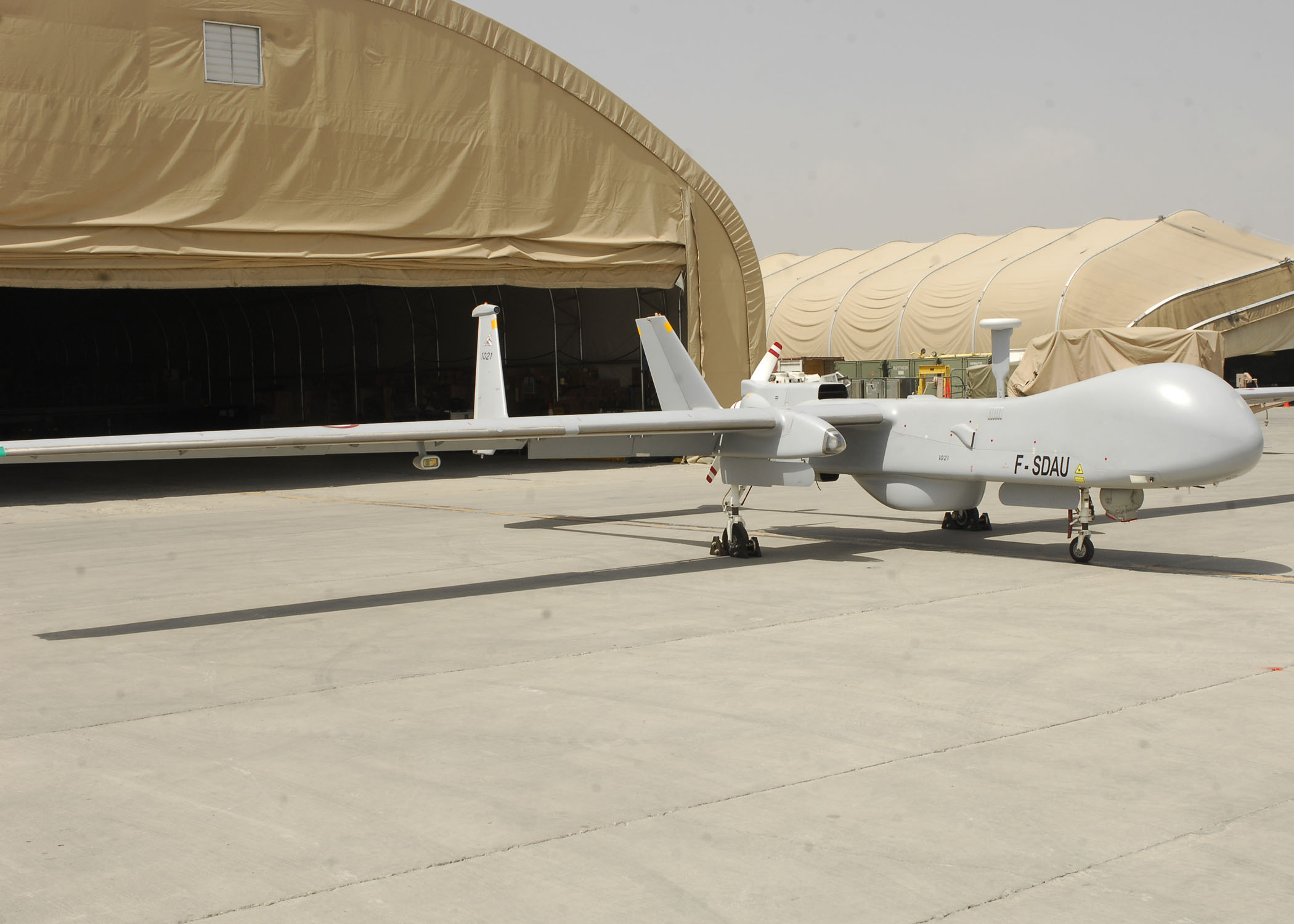Strategic Implications
ISR and Strikes
Currently, France is using drones only for ISR missions. Specifically, these operations include intelligence preparation of the battlefield, supporting conventional and special operation troops in contact during engagements, monitoring suspected jihadists, and finding or rescuing hostages.
In current air force doctrine, unarmed MALE Harfangs and Reapers complement fighter jets, armed helicopters, or any system capable of delivering a precision strike. In Niamey, they are paired with two Mirage 2000Ds and two Mirage 2000Cs as well as with the Rafales based in N’djamena that conduct the strikes. Fighter pilots insist on the added value of working with drones. When scrambled to assist troops in contact, for example, they first examine drone images to learn the geographical situation. RPAs can also lase targets for the fighters or maritime patrol aircraft (Atlantique 2).
Arming the currently unarmed French Reapers is controversial.12 The objective of doing so would be to cover the entire kill chain (find, fix, track, target, engage, assess). There is also a humanitarian argument that arming the drones would save time and therefore increase discrimination. While conducting strikes is not a priority – because more is learned from capturing the target – when the mission is to strike, it can currently only be conducted by manned aircraft. In the time needed for the aircraft to arrive in the zone, however, the target could have moved into an environment where the risk of collateral damage is far higher.
Targets
Before arming its drones, France must consider what kinds of targets and military operations they would be used for. Armed Reapers would be used against the same non-state targets France is fighting today with unarmed drones and fighter jets in the Sahel. Being missile-fitted surveillance drones, armed Reapers are slow, not stealthy, and relatively not maneuverable. Therefore, they can only be used in permissive airspace. In the future, UCAVs will be able to penetrate hostile or denied airspace and could therefore be used against state targets without the need to first destroy enemy integrated air defense systems. The dichotomy between non-state and state actors will be blurred when non-state actors acquire strong anti-aircraft capabilities. In the unlikely event that ISIS were to acquire – and be able to operate – an S-300 advanced surface-to-air missile system, for example, it would be much more difficult for MALEs, such as the Reaper, or other air assets to operate safely.
Missions
France is already using drones for all kinds of missions: short-range missions within its own borders, cross-border operations into neighboring countries’ territories, longer-range regional or global missions, and expeditionary operations.
Domestically, some companies are using small drones to survey strategic infrastructure and will use larger drones to fly over linear infrastructure (railways, pipes, electrical communication). For now, the Harfang is the only MALE in the French air force inventory allowed to fly over the national territory, and it is used for high-profile events (e.g., national day parade in Paris, high-level official visits). The current contract with the United States confines the Reaper to the Sahel, but there are discussions of introducing it into French airspace. Using MALE drones within France’s borders and for cross-border operations would be useful for monitoring migration flows in the Mediterranean Sea, drug traffickers, potential transnational terrorists, national parks, and forest fires. They could also support helicopters deployed in response to a terrorist attack. Launched and piloted from the Cognac Air Base, they could be operational anywhere in France within a few hours.13 The MALE, operated by either the navy or the air force, could also complement the French navy for maritime patrolling.14 France has the second-largest exclusive economic zone in the world and insufficient manned means to patrol such a huge area.15
Perceptions
How will France perceive drones compared with traditional human-inhabited aircraft? Lacking an internal pilot, drones have two main characteristics: Their persistence provides real-time knowledge, and the crew’s physical separation reduces risk (but, contrary to a widespread belief, does not totally suppress risk as French drones were operated in situ from Bagram, Afghanistan, and currently are operated from Niamey, Niger – not to mention the direct risk to launch & recovery and technical teams). The first characteristic is why French drones already perform new operations, compared with traditional human-inhabited aircraft, with their ISR persistence providing superior information for a lower cost in external operations.
Drones have not yet reduced risk, at least for the air force, which is still using traditional human-inhabited aircraft for higher-risk operations. The French air force is not inclined to take more risks with its drones for at least two reasons. First, the current MALEs can only be deployed in permissive, low-risk airspace. Second, with only three Reapers today and nine more planned in the coming years, France is reluctant to place its “new toys” in harm’s way.
Therefore, France is no more willing to deploy a drone in a contested area than a traditional human-inhabited aircraft. The UCAVs will change this in the future, as they will be specifically designed to penetrate and survive in such areas. However, this does not mean that France will always use a UCAV rather than a traditional human-inhabited aircraft. France is working on combination scenarios in which UCAVs are used to saturate the airspace while Rafales penetrate it at very low altitude.
In general, France disproves the presumption that a state is always more likely to accept risk with a drone than with a human-inhabited aircraft, because it depends on external factors such as cost, the number of available units, and the strategic and political context. For the same reason, the deployment of French MALE drones does not signal greater or lesser resolve than does use of traditional human-inhabited aircraft. It signals only a requirement; they are deployed where no human-inhabited aircraft can do the same job.
Threats
On the national territory, the proliferation of hobbyist systems is concerning. France, like other countries, is affected by flights over restricted government areas (e.g., Elysée presidential palace and nuclear facilities). For now, such flights are interpreted as harming the credibility of the authorities more than a real threat, but the possibility of disruptive employment by non-state actors of weaponized hobbyist systems in the future is taken seriously.
The probability of others sending MALE or HALE drones into France’s territory is very low. Only France’s allies have flown drones into its airspace with its consent during military exercises (an American Global Hawk and an Italian Reaper in 2014). Air defenses would quickly shoot down any unauthorized intrusion, particularly if the drone was thought to be armed.
Outside the national territory and in regions where France operates militarily, France’s allies – the United States and the United Kingdom – are most likely to send drones. Maintaining air superiority in all its current external operations – in the Sahel-Saharan strip, Iraq, and the Central African Republic – France is not threatened by foreign drones as long as persistent air or ground radar coverage is maintained. Small drones operated by non-state actors, such as ISIS, are used for propaganda and do not constitute a serious threat.
Non-state actors do not yet possess the technology, such as scramblers, to deny or disrupt France’s use of drones, but it is only a matter of time before they do. Securing satellite communications should thus be a priority. In Niamey and other deployment sites, the greatest risk now for a MALE RPA is to be shot down during takeoff and landing.


 Military tactical: The army has been using tactical drones for 50 years and has a strong expertise in these systems.4 Currently, it possesses around 20 French Sagem (Safran) SDTI Sperwers, eight of which flew in Afghanistan for a total of more than 2,000 hours in 800 missions. As successor to the SDTI, the Sagem Patroller was finally selected over the Watchkeeper WK450 (developed by the French company Thales UK from an Israeli Elbit Hermes 450 made for the British army). Fourteen of the Patrollers will be delivered to the French army in 2018. The navy sees drones as a complement to its manned helicopters for the “3D jobs” (dull, dirty, dangerous). It tested the Austrian Schiebel Camcopter S-100, which it calls Serval, on the patrol vessel L’Adroit and is seeking to acquire a tactical heli-drone in the 700- to 2,000-kilogram category. The navy could additionally need medium-altitude long-endurance (MALE) remotely piloted aircrafts (RPAs) with specific sensors, such as maritime surveillance radar and an automatic identification system receptor.5 The navy also intends to develop a system of tactical aerial drones for the marines (SDAM) by 2020.
Military tactical: The army has been using tactical drones for 50 years and has a strong expertise in these systems.4 Currently, it possesses around 20 French Sagem (Safran) SDTI Sperwers, eight of which flew in Afghanistan for a total of more than 2,000 hours in 800 missions. As successor to the SDTI, the Sagem Patroller was finally selected over the Watchkeeper WK450 (developed by the French company Thales UK from an Israeli Elbit Hermes 450 made for the British army). Fourteen of the Patrollers will be delivered to the French army in 2018. The navy sees drones as a complement to its manned helicopters for the “3D jobs” (dull, dirty, dangerous). It tested the Austrian Schiebel Camcopter S-100, which it calls Serval, on the patrol vessel L’Adroit and is seeking to acquire a tactical heli-drone in the 700- to 2,000-kilogram category. The navy could additionally need medium-altitude long-endurance (MALE) remotely piloted aircrafts (RPAs) with specific sensors, such as maritime surveillance radar and an automatic identification system receptor.5 The navy also intends to develop a system of tactical aerial drones for the marines (SDAM) by 2020. Political: France’s commitment to an independent foreign policy heightens issues of sovereignty. The Reapers’ efficiency is widely acknowledged, but a minority of politicians and journalists denounce a triple dependency: (1) Lacking simulators, French pilots are only trained in the United States in competition with the United States’ own needs. Moreover, French Block-1 Reapers have been launched by U.S. General Atomics (GA) contractors during takeoff and landing (since January 2016, the French Air Force is now authorized to take over, but will first need to train its pilots); (2) Only GA can fix and replace the spare parts, which could be an additional constraint; and (3) Conditions of use are fixed by the American Congress, meaning that France needs the consent of Washington to deploy its Reapers. Also, there is a risk that America’s position regarding French deployment could become less flexible in the future. Such criticism should be put into perspective, as focusing exclusively on the Reapers is unfair since French forces use a number of other foreign pieces of equipment, including the Harfang, E-3F AWACS, E-2C Hawkeye, guided bomb unit (GBU) bombs, and even the Charles de Gaulle aircraft carrier catapults. Secondly, France accepted these restrictions when it chose to acquire the U.S. version of the Reapers – a privilege it shares only with the United Kingdom – and to avoid waiting for the Block-5 export variant in 2017. France has become the United States’ first strategic partner in the war on terror, so this alliance is crucial. As for GA, its professionalism and reactivity have already proved decisive on several occasions.
Political: France’s commitment to an independent foreign policy heightens issues of sovereignty. The Reapers’ efficiency is widely acknowledged, but a minority of politicians and journalists denounce a triple dependency: (1) Lacking simulators, French pilots are only trained in the United States in competition with the United States’ own needs. Moreover, French Block-1 Reapers have been launched by U.S. General Atomics (GA) contractors during takeoff and landing (since January 2016, the French Air Force is now authorized to take over, but will first need to train its pilots); (2) Only GA can fix and replace the spare parts, which could be an additional constraint; and (3) Conditions of use are fixed by the American Congress, meaning that France needs the consent of Washington to deploy its Reapers. Also, there is a risk that America’s position regarding French deployment could become less flexible in the future. Such criticism should be put into perspective, as focusing exclusively on the Reapers is unfair since French forces use a number of other foreign pieces of equipment, including the Harfang, E-3F AWACS, E-2C Hawkeye, guided bomb unit (GBU) bombs, and even the Charles de Gaulle aircraft carrier catapults. Secondly, France accepted these restrictions when it chose to acquire the U.S. version of the Reapers – a privilege it shares only with the United Kingdom – and to avoid waiting for the Block-5 export variant in 2017. France has become the United States’ first strategic partner in the war on terror, so this alliance is crucial. As for GA, its professionalism and reactivity have already proved decisive on several occasions.